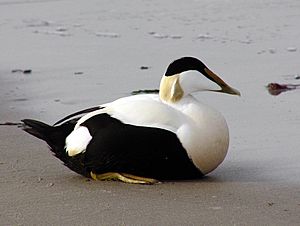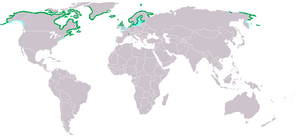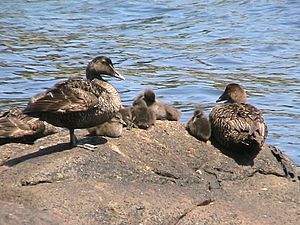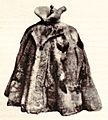Common Eider facts for kids
Quick facts for kids Common Eider |
|
|---|---|
 |
|
| Adult drake | |
| Conservation status | |
| Scientific classification | |
| Kingdom: | |
| Phylum: | |
| Class: | |
| Order: | |
| Family: | |
| Subfamily: | |
| Genus: | |
| Species: |
S. mollissima
|
| Binomial name | |
| Somateria mollissima (Linnaeus, 1758)
|
|
| Subspecies | |
(European Eider)
(Faeroe Eider)
(North Pacific Eider)
(North Atlantic Eider)
(Hudson Bay Eider)
(American Eider) |
|
 |
|
| Green: breeding Blue: winter/feeding |
|
The Common Eider (Somateria mollissima) is a very large sea-duck. These amazing birds live along the northern coasts of Europe, North America, and eastern Siberia. They build their nests and raise their young in cold Arctic areas. Some also breed in northern temperate regions.
During the colder months, Common Eiders fly south to warmer temperate areas. Here, they often gather in huge groups on the ocean. They are fast flyers, reaching speeds up to 113 kilometers per hour (70 miles per hour)!
Contents
What Does a Common Eider Look Like?
The Common Eider is the biggest of all four eider species. It is also the largest duck found in Europe and North America. These ducks can be from 50 to 71 centimeters (20 to 28 inches) long. They weigh between 0.81 and 3.04 kilograms (1.8 to 6.7 pounds). Their wings can spread out from 80 to 110 centimeters (31 to 43 inches).
Common Eiders have a strong, bulky body shape. They also have a large, wedge-shaped bill. The male Common Eider is easy to spot. It has striking black and white feathers and a green patch on its nape (the back of its neck). Female eiders are brown birds. You can tell them apart from other ducks by their large size and unique head shape. The call of this duck sounds like a pleasant "ah-ooo." These birds are often quite friendly and easy to get close to.
What Do Common Eiders Eat?
Common Eiders are expert divers. They dive underwater to find crustaceans and molluscs. Their favorite food is mussels. Eiders swallow mussels whole. The strong shells are then crushed inside their gizzard (a special part of their stomach). After that, the shells are passed out of their body. When an eider catches a crab, it first removes all the claws and legs. Then, it eats the body in a similar way.
How Do Common Eiders Live Together?
Common Eiders are social birds. They like to nest together in large groups called colonies. These colonies are found on coastal islands. Some colonies can have fewer than 100 birds. Others can be huge, with 10,000 to 15,000 individual birds!
Female eiders often return to the very same island where they were born to lay their own eggs. This means that many of the birds nesting on the same island are often related to each other.
Images for kids
-
Adult male in eclipse plumage
-
Common eider (female) on the dune, Heligoland
-
Common eider (male) on the dune, Heligoland
See also
 In Spanish: Eider común para niños
In Spanish: Eider común para niños



















